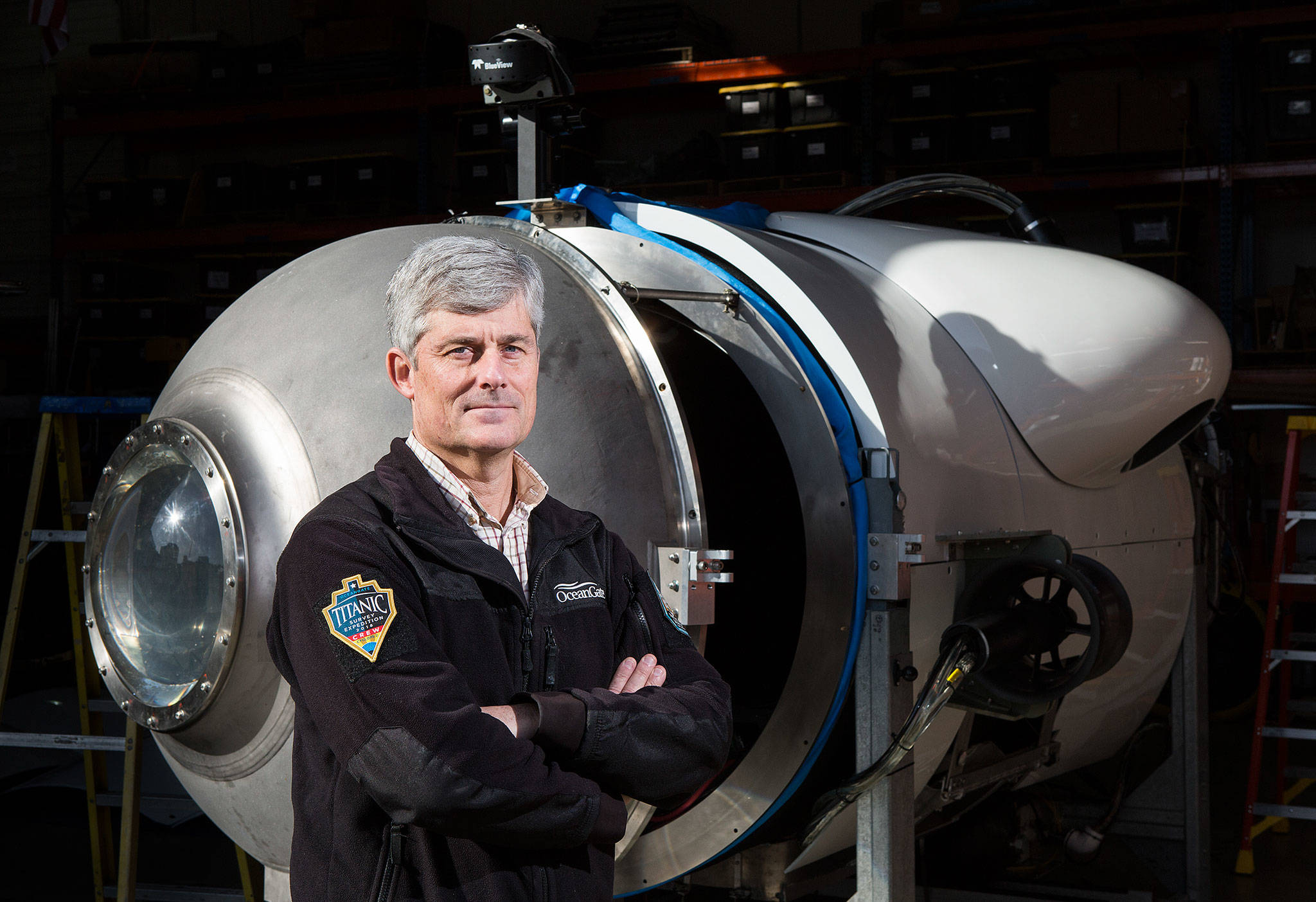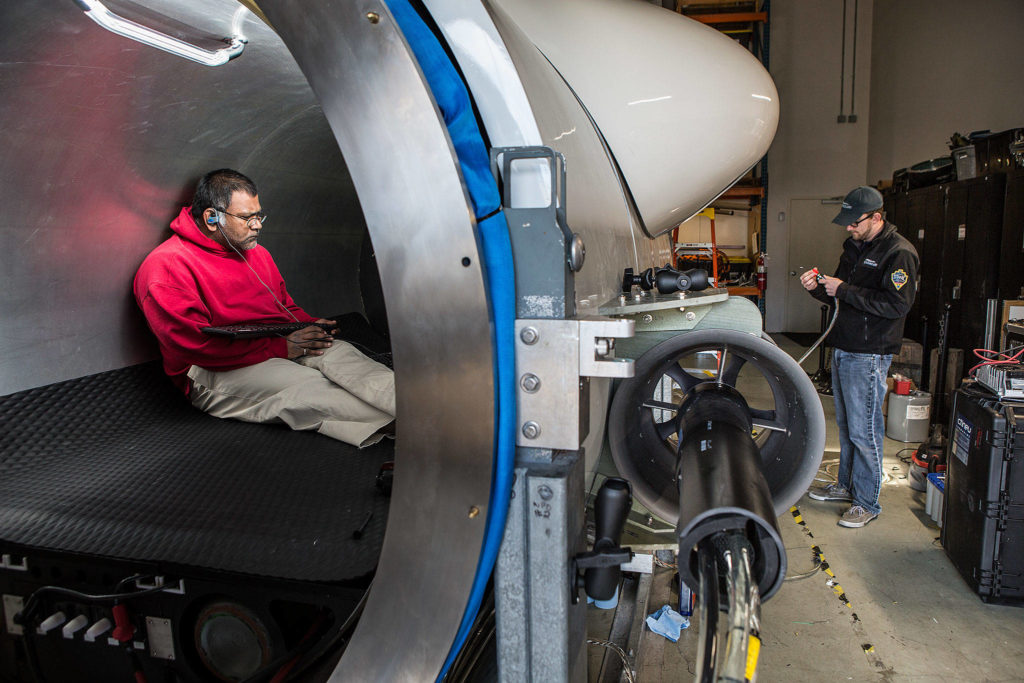When Stockton Rush was a kid, he wanted to be an astronaut exploring the unknowns of space.
About 15 years ago, he realized there were still unknown spaces to explore here on Earth. Among them were the depths of the Atlantic Ocean — and the world’s most famous shipwreck.
Rush is the co-founder and CEO of OceanGate, an Everett-based company that pushes ocean exploration and research. OceanGate is now testing its latest submersible, Titan. The sub will take Rush and his clients to the bottom of the Atlantic and allow them an up close look at the wreck of the RMS Titanic. The ship sank on its maiden voyage in 1912 after colliding with an iceberg in the north Atlantic.
OceanGate’s previous submersible was Cyclops I, which was used to explore the wreck of the Andrea Doria off Nantucket Island in Massachusetts. Cyclops I had a 1-inch-thick steel hull and was able to dive to a depth of 500 meters, or about 1,640 feet. To dive 12,500 feet to reach the Titanic, OceanGate needed a submersible that would be able to withstand the pressure at that depth.
Enter Titan.
Titan has a 5-inch-thick carbon fiber hull, and 3 1/4-inch titanium hemispheres on either end that serve as the crew’s access hatches. It can dive up to 4,000 meters or more than 13,000 feet, and withstand more than 160 million pounds of pressure, Rush said.
Titan is undergoing test trials in Puget Sound as an OceanGate crew tests its buoyancy, how fast it can move up and down, as well as other systems — sonar, cameras, lighting, laser scanners and more.
“There’s a lot of components, the vast majority of which don’t care whether you’re 10 feet underwater or 10,000,” Rush said. “So we can test all of that here and if we have problems, maybe we can solve all that locally.”
Titan will finish testing in Puget Sound during the first part of April, then the crew will move on to deep-water testing in the Bahamas.
“We need to get to 4,000 meters, and to do that off the coast of Washington, we have to go 300 miles out to sea,” Rush said. “To do that in the Bahamas, it’s 15 miles.”
In addition to testing the Titan, OceanGate will also test a custom launch platform made by Burlington-based Everest Marine. The 11-ton aluminum platform was designed specifically for OceanGate’s subs — the launch platform and the sub create an integrated system that can be lowered under water together.
In the past, ships needed an A-frame or a crane to launch and recover manned subs. The launch platform is like a barge that is towed behind the ship, Rush said. Crews can transfer to the sub from the main ship on a light Zodiac boat instead of a heavy boat with the potential to injure someone.
“We sink (the platform) and then sub leaves from where it’s nice and calm out of the waves so you don’t join these heavy objects on the surface,” he said.
The advantage of the custom launch platform is that OceanGate can use almost any local ship that’s available, cutting down on expenses.
Crews can launch Titan by flooding the platform’s ballast tanks and submerging the unit about 30 feet under water. Once beneath the rough waves common in open water, the sub will lift off the platform and begin the dive.
Submerging the launch platform and sub together reduces the risk of danger to the crew, Rush said. In rough seas, a submersible trying to launch from an A-frame or crane can swing at a different rate than the ship is moving. This can increase the danger to the crew, Rush said.
“The worst place in the world is between the sea and the air,” Rush said.
Jim Nagel of Everest Marine said creating the launching platform with OceanGate was a spepcial opportunity.
“We couldn’t be prouder of this project and the opportunity it provides for the advancement of ocean exploration,” Nagel said in a press release.
The deep dives in the Bahamas will also allow the company to test the surface support systems and other logistics, including transporting the equipment, and loading and unloading the submersible crew.
After the tests in the Bahamas, Rush hopes to dive to the Titanic in June.
Rush’s interest in developing a deep-water submersible began with a cold-water scuba dive at Nanaimo in 2003. He enjoyed the dive, but didn’t enjoy wearing all the gear that came with it. Rush looked into renting a sub, but discovered that wasn’t really an option.
Digging a little deeper, Rush thought he found a market among travelers looking for experiences off the beaten path.
“Maybe there will be an area where you could find affluent individuals who wanted to participate in ocean research and exploration,” he said. “That was the genesis of OceanGate.”
Rush calls his clients “mission specialists,” and each one will have a role to play in gathering research during the dives to the Titanic. The last manned submersible explored the wreck in 2005; a 2010 dive using autonomous underwater vehicles mapped the wreck and its debris field. Rush hopes that the technology on Titan will deliver more detail of the wreck than was possible eight years ago. This includes using multiple 4K cameras, a laser scanner and 50,000 lumens of external light.
Titan also features a steering system that uses a standard PlayStation controller. Mission specialists on dives will get a chance to steer the sub, Rush said.
“Once I get to the bottom, I can teach you to drive it in about 30 seconds,” he said.
Rush hopes repeated dives in the submersible will document the decay of the Titanic year after year, discover new marine life and possibly find artifacts in the ship’s debris field.
“I think every dive will be full of many new discoveries,” he said.
Talk to us
> Give us your news tips.
> Send us a letter to the editor.
> More Herald contact information.


























